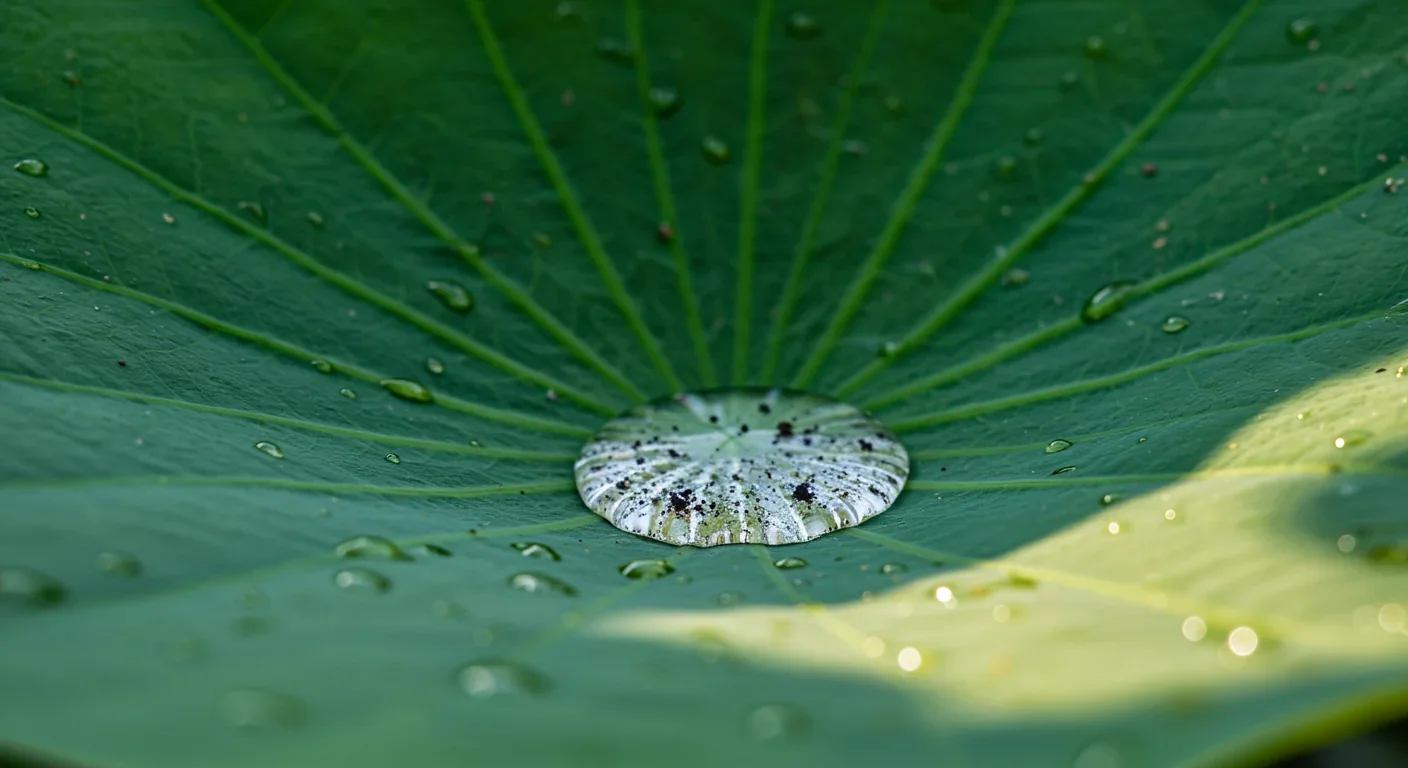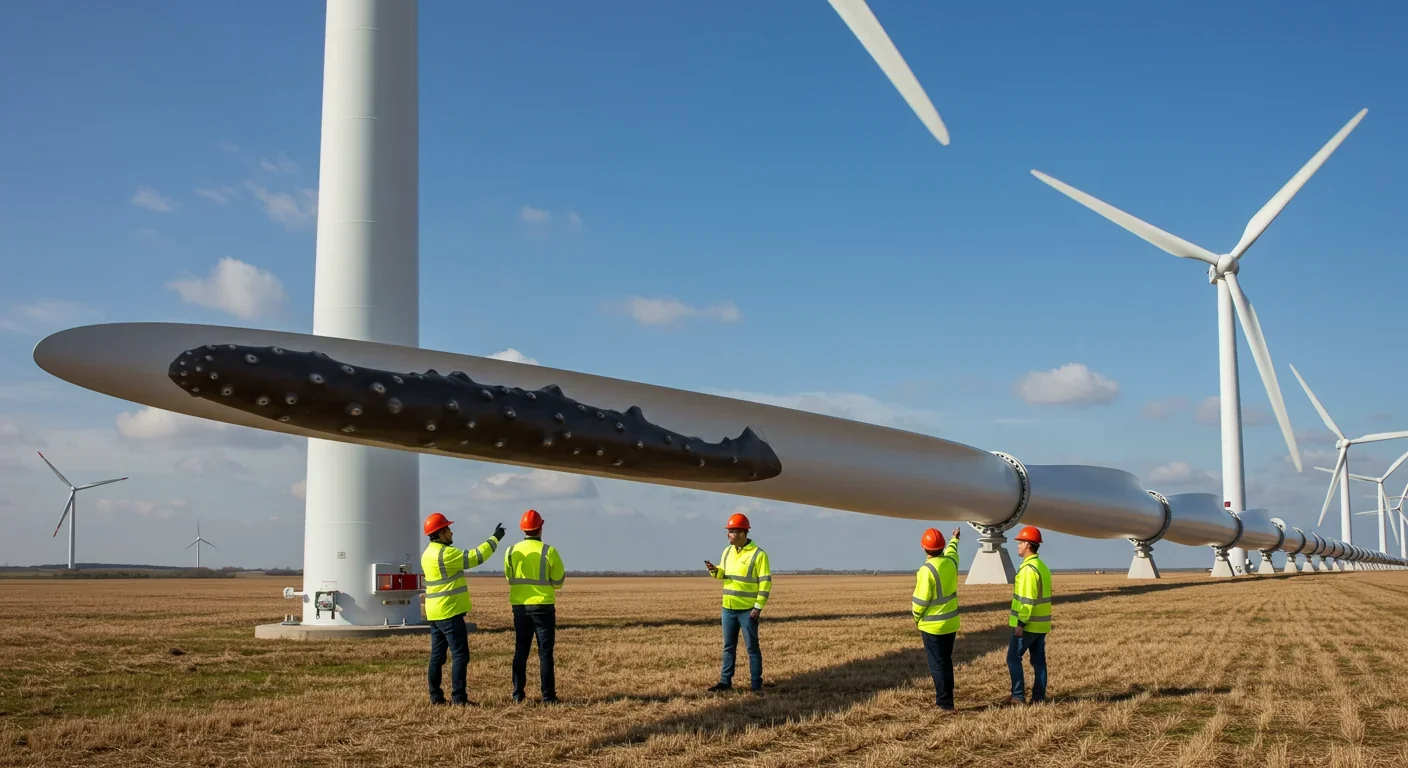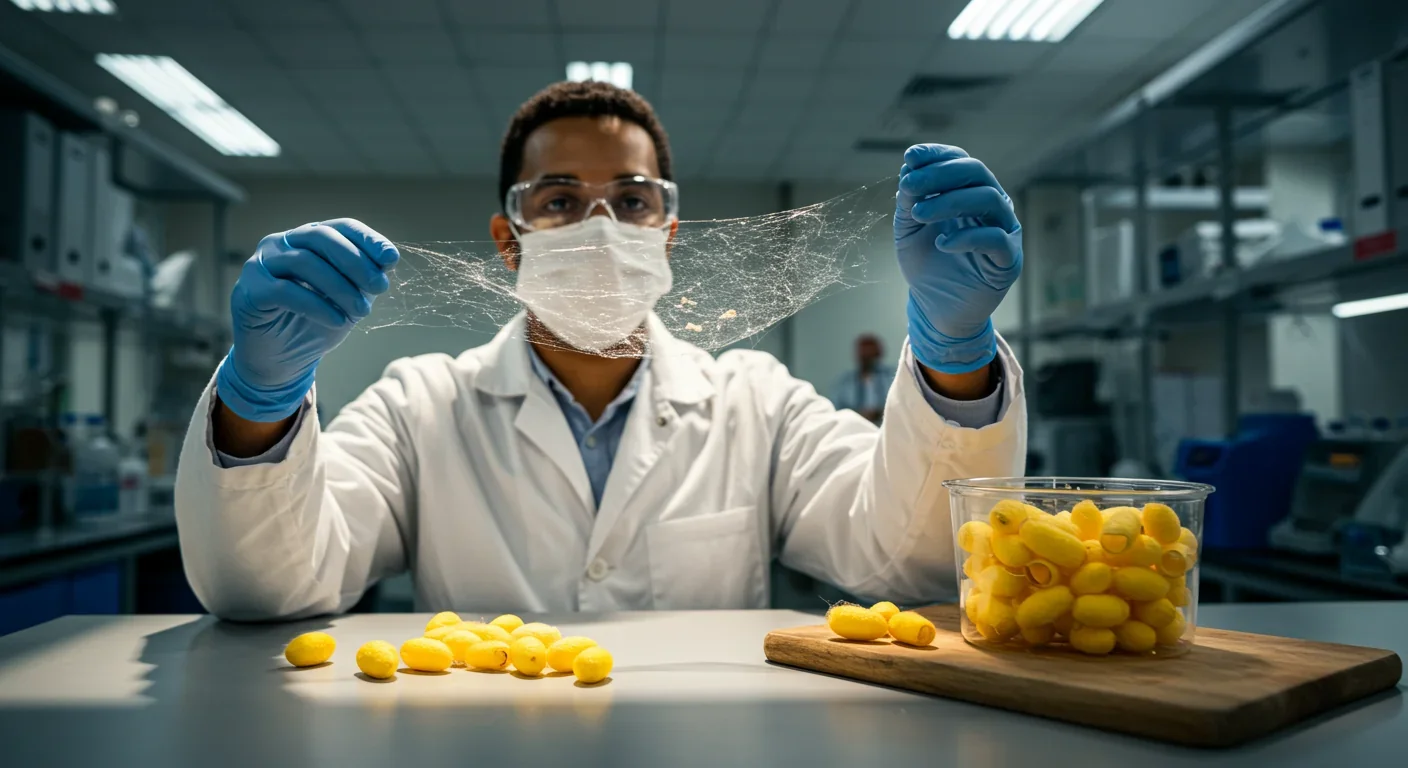Digital Pollution Tax: Can It Save Data Centers?

TL;DR: Nature's 3.8 billion years of R&D are revolutionizing technology. From lotus-inspired self-cleaning surfaces to whale-fin wind turbines, biomimicry is delivering both performance gains and sustainability in a $25.67B market by 2033.

A water droplet lands on a traffic sign in the Netherlands, then rolls right off, taking dust and grime with it. Across the Atlantic, a wind turbine spins smoothly in conditions that would stall conventional blades. In a Stanford lab, a robotic gripper clings to a satellite panel at negative 47 degrees Celsius. These aren't coincidences—they're the result of engineers looking at lotus leaves, humpback whales, and gecko feet with fresh eyes.
Biomimicry isn't just about copying nature. It's recognizing that evolution has already solved most of the problems we're throwing billions at. After 3.8 billion years of research and development, nature has optimized designs that human engineering is only beginning to understand. The biomimetic technology market tells the story in numbers: from $12.34 billion in 2024 to a projected $25.67 billion by 2033. That's a 9.2% annual growth rate, driven by companies realizing that the best solutions might already exist in a forest, ocean, or desert.
Humans have always borrowed from nature. Leonardo da Vinci sketched flying machines based on bird wings in the 15th century. The Wright brothers studied buzzards before Kitty Hawk. Velcro came from burrs stuck to a dog's fur in 1941. But what's happening now feels different because the scale and sophistication have changed completely.
Earlier biomimicry relied on what you could see with your eyes. Modern scientists work at the nanometer level, using electron microscopes and computational modeling to decode biological structures that are invisible to human vision. When researchers at the Chinese Academy of Sciences developed self-cleaning smart windows, they didn't just look at lotus leaves—they mapped the precise geometry of microscopic bumps that make water bead up and roll away.
This shift from macro to nano opened up entirely new possibilities. You can't replicate what you can't see, and for most of human history, we simply couldn't see the mechanisms that made nature's designs work. The printing press democratized knowledge. The microscope revealed a hidden world. Now, nanotechnology is letting us actually build at nature's scale.
The lotus effect sounds almost magical until you understand the physics. Lotus leaves stay pristine in muddy ponds because their surface is covered in nanoscale bumps coated with a waxy substance. Water droplets can't spread out—they ball up, sitting on the tips of these bumps like a person standing on a bed of nails. As the droplets roll off, they collect dirt particles and carry them away.
Replicating this took more than just roughening up a surface. The smart window developed in 2025 uses hydrophobic silica nanoparticles applied over silver nanowire heaters. When you apply five volts, the window switches from 84.9% light transmittance to just 11% in 36 seconds, cutting indoor temperatures by up to 6.5 degrees Celsius. The surface mimics the lotus so well that water, coffee, even ethylene glycol just rolls off without leaving residue.
But the real breakthrough came in durability. Early lotus-effect coatings scratched easily, limiting their use to protected environments. Chemona's Multi-Coat solved this by creating a PFAS-free nano-coating tough enough for traffic signs. Dutch municipalities were spending €250,000-500,000 annually cleaning signs. One layer of the coating slashed those costs while improving visibility and road safety.
The applications keep expanding. Synthetic resin roof tiles now use the lotus effect to stay clean for decades. Medical devices employ it to prevent bacterial buildup. Solar panels keep themselves clean, maintaining efficiency without manual washing. Each application saves water, reduces chemical use, and cuts maintenance costs—practical sustainability that pencils out on a spreadsheet.
Humpback whales are not streamlined. They have big bumps—tubercles—running along the leading edge of their flippers. For years, this puzzled biologists because conventional wisdom said smooth surfaces reduce drag. Then researchers realized the whales weren't minimizing drag. They were managing it.
Those tubercles create tiny vortices that keep water flowing smoothly over the flipper even at steep angles, allowing humpbacks to make impossibly tight turns while hunting. When engineers applied this to wind turbines, the results were remarkable. Blades with tubercle-inspired ridges increased the lift-to-drag ratio enough to lower optimal wind speed by approximately 15%.
Think about what that means. A wind farm that was marginal at a particular location suddenly becomes viable. Turbines can harvest energy from gentler winds, expanding the geography where wind power makes economic sense. The dual-rotor design with humpback-inspired blades doesn't just improve efficiency—it reduces noise, addressing one of the main objections communities have to wind installations.
This innovation shows how biomimicry challenges assumptions. Engineers spent decades trying to make turbine blades smoother, when the answer was to make them strategically bumpy. The whale wasn't fighting physics but working with it in a way we'd never considered. Sometimes the best solution isn't optimization of an existing approach but questioning whether you're solving the right problem.

Geckos can run up walls and across ceilings because of microscopic hair-like structures called setae on their toe pads. Each seta branches into hundreds of even tinier spatulae that create weak intermolecular forces called van der Waals interactions. Individually, these forces are negligible. Collectively, across millions of contact points, they can support the gecko's entire body weight.
The challenge was making this work in engineering. Early gecko-inspired adhesives worked great in lab conditions but failed in the real world. Temperature fluctuations, dust, and repeated use degraded performance. Then Stanford and Georgia Tech researchers developed an adhesive that functions at negative 47 degrees Celsius in space-relevant environments.
This opens up applications that seemed like science fiction. Robots can now grab and manipulate satellites without mechanical grippers that might damage sensitive equipment. Surgical tools can grip tissue without crushing it, since the adhesion is distributed across the entire contact surface rather than concentrated at a clamp point. The directional nature of the adhesive—strong when pulled one way, easy to release when peeled—gives robots a level of dexterity that's been hard to achieve mechanically.
Spider silk has been the holy grail of materials science for decades. By weight, it's stronger than steel and tougher than Kevlar, yet it's produced at room temperature from protein solutions. No high heat, no toxic chemicals, just a spider and some flies. For years, reproducing this seemed impossible because we couldn't replicate the spider's complex spinning process.
Kraig Bioengineering Labs cracked the code by using transgenic silkworms to produce spider silk proteins. This is biomimicry at the genetic level—transplanting the biological machinery that makes spider silk into an organism that's already domesticated and scaled for commercial production. The result is a sustainable alternative to petroleum-derived plastics and synthetic fibers.
The applications range from military body armor to biodegradable microplastics that break down harmlessly. The textile industry, which accounts for roughly 10% of global carbon emissions, could shift to a material that's produced biologically and degrades naturally. Medical sutures made from spider silk can be absorbed by the body, eliminating the need for removal surgeries.
What makes spider silk particularly interesting is that it's not just one material but a class of materials. Different spider species produce silks with different properties, optimized for different purposes—sticky capture spirals, tough draglines, fine egg sac silk. We're not copying a single design but gaining access to an entire materials library that evolution has already tested.
When you cut your skin, it heals. When you crack concrete, it stays cracked. This asymmetry has bothered engineers for decades, especially since infrastructure repair accounts for enormous costs. Bridges, roads, and buildings degrade from microscopic cracks that propagate over time, eventually requiring expensive maintenance or replacement.
Self-healing materials borrow from biological systems that sense damage and respond with repair mechanisms. Some incorporate bacteria that lie dormant in concrete until cracks form, then consume oxygen and produce limestone to fill the gaps. Others use microcapsules filled with healing agents that break when cracks propagate, releasing substances that harden and seal the damage.
The economic implications are staggering. Infrastructure that repairs its own small damage would last decades longer, reducing the backlog of deferred maintenance that most developed countries are struggling with. The environmental benefits follow directly—less material production, less construction equipment, fewer resources tied up in making replacements for things that wear out prematurely.
Understanding why these designs work requires diving into principles that span multiple disciplines. The lotus effect relies on surface chemistry and fluid dynamics. Humpback tubercles manipulate boundary layer separation and vortex formation. Gecko adhesion exploits quantum mechanical forces that only matter at molecular scales.
This is where modern biomimicry parts ways with historical examples. You don't need to understand aerodynamics to see that birds fly and think about making wings. But you do need electron microscopy, computational fluid dynamics, and materials science to figure out why a specific nanostructure repels water or how to manufacture artificial setae that create van der Waals forces.
The Engineering for One Planet program has enabled more than 600 engineering courses at over 80 institutions, impacting nearly 40,000 students who are learning to think this way. The curriculum doesn't treat biology as separate from engineering but as a source of proven solutions that can be adapted to human needs.
This cross-disciplinary approach is essential because natural designs rarely map directly to engineering problems. A bird wing doesn't work like an airplane wing—it's more complex, serving multiple functions simultaneously. The translation process requires understanding both the biological principle and the engineering constraint, then finding the intersection where natural strategies can be applied to human challenges.

Markets respond to incentives, and biomimicry is passing the cost-benefit test. Smart windows that combine optical regulation, self-cleaning, and thermal control into a single thin device save energy, reduce maintenance, and last longer than conventional solutions. The power consumption of just 8 × 10⁻³ W cm⁻² °C⁻¹ means operational costs are negligible compared to active cooling systems.
The business case gets stronger when you factor in secondary benefits. Self-cleaning surfaces reduce water use and chemical runoff. More efficient wind turbines lower the levelized cost of renewable energy. Spider silk production uses a fraction of the energy required for synthetic fiber manufacturing. Each innovation solves multiple problems simultaneously, creating value in ways that single-purpose technologies can't match.
Investment patterns reflect this. The biomimetic technology market's 9.2% compound annual growth rate is accelerating as more companies recognize that nature-inspired designs often deliver performance improvements and cost reductions together, not as a tradeoff. Early entrants that build robust platforms and ecosystems are positioning themselves to dominate as the sector consolidates around proven solutions.
Despite the promise, biomimicry faces real obstacles. Biological systems evolved in specific contexts that don't always match human requirements. A lotus leaf doesn't need to survive highway salt spray or industrial pollutants. Gecko feet regenerate constantly, while manufactured adhesives need to maintain performance for years without biological renewal mechanisms.
Scaling is another persistent challenge. Kraig Labs' spider silk breakthrough worked because silkworms are already domesticated, but most biological production systems don't scale easily. Manufacturing processes that work in nature might require conditions that are impractical or too expensive to replicate industrially.
There's also a risk of oversimplification. Nature doesn't optimize for single variables—organisms balance competing demands like energy efficiency, predator avoidance, and reproduction. When engineers extract one feature from a biological system, they might lose synergies that made the original design work. The lotus effect requires specific materials, geometries, and surface chemistries working together, and replicating just one element often isn't enough.
If you're thinking about integrating biomimicry into your projects, start with a clear understanding of the problem you're solving, not the biological inspiration you find interesting. Nature offers solutions, not products. The gap between "dolphins echolocate" and "we should make sonar" is much smaller than the gap between "butterfly wings have nanostructures" and a profitable photonics company.
Research existing solutions thoroughly. The Biomimicry Institute's AskNature database catalogs thousands of biological strategies indexed by function. Before you reinvent the wheel, check whether someone has already translated the biological principle you're interested in, what challenges they encountered, and where opportunities remain.
Build cross-disciplinary teams from the start. You need biologists who understand how organisms actually work, engineers who can translate that into manufacturable designs, and business people who can identify markets where the innovation delivers real value. These skillsets rarely overlap, and the translation process requires deep collaboration, not just consultation.
Focus on applications where biomimetic designs offer clear advantages over existing solutions. Self-cleaning surfaces make sense for places that are hard or expensive to clean manually. Gecko adhesives work for applications requiring gentle, repeatable attachment. Don't try to compete with cheap, established technologies on price alone—compete on capabilities that conventional approaches can't match.
Looking ahead, three trends will shape how biomimicry evolves. First, AI and machine learning will accelerate the discovery process. Instead of researchers stumbling onto interesting biological phenomena, algorithms can screen millions of organisms for specific properties, then model how those properties could be adapted for engineering applications.
Second, synthetic biology will blur the line between copying nature and programming it directly. Rather than trying to manufacture structures that mimic gecko feet, we might grow them using modified organisms as biological factories. This moves beyond inspiration into direct biological production, potentially offering lower costs and higher fidelity to natural designs.
Third, as climate pressures intensify, the sustainability advantages of biomimicry will become harder to ignore. Technologies that use less energy, produce less waste, and work with rather than against natural systems will go from nice-to-have to essential. Companies that master bio-inspired design now will have a significant advantage as environmental costs get properly accounted for in economic decisions.
The ten-year vision that organizations like the Biomimicry Institute are advancing points toward a future where looking to nature first becomes standard practice in design and engineering. That shift would represent a fundamental change in how humans approach technology, moving from dominating natural systems to learning from and integrating with them.
If biomimicry reaches its potential, you won't notice most of it. Buildings will clean and maintain themselves without fanfare. Wind farms will quietly produce more energy at lower cost. Medical procedures will be less invasive, using tools that manipulate tissue with biological gentleness. Infrastructure will last longer, requiring less replacement.
The technology will fade into the background, which is exactly what good engineering does. You don't think about the transistor count in your phone or the aerodynamics of your car's shape. They just work. The measure of success for biomimicry isn't whether you can identify which products use lotus-effect coatings or gecko-inspired adhesives. It's whether those products solve problems more elegantly, efficiently, and sustainably than the alternatives.
Right now we're in the early phase where each innovation is noteworthy and companies market their bio-inspired features explicitly. Give it a decade, and nature-based design will be so common that mentioning it would be like advertising that your software uses math. The question won't be whether to look at biological solutions but which of the millions of strategies evolution has produced best addresses your specific challenge.
That future is being built today in labs where researchers map butterfly wings and fields where engineers test whale-inspired turbine blades. The blueprints have been out there for millions of years. We're finally learning to read them.

Recent breakthroughs in fusion technology—including 351,000-gauss magnetic fields, AI-driven plasma diagnostics, and net energy gain at the National Ignition Facility—are transforming fusion propulsion from science fiction to engineering frontier. Scientists now have a realistic pathway to accelerate spacecraft to 10% of light speed, enabling a 43-year journey to Alpha Centauri. While challenges remain in miniaturization, neutron management, and sustained operation, the physics barriers have ...

Epigenetic clocks measure DNA methylation patterns to calculate biological age, which predicts disease risk up to 30 years before symptoms appear. Landmark studies show that accelerated epigenetic aging forecasts cardiovascular disease, diabetes, and neurodegeneration with remarkable accuracy. Lifestyle interventions—Mediterranean diet, structured exercise, quality sleep, stress management—can measurably reverse biological aging, reducing epigenetic age by 1-2 years within months. Commercial ...

Data centers consumed 415 terawatt-hours of electricity in 2024 and will nearly double that by 2030, driven by AI's insatiable energy appetite. Despite tech giants' renewable pledges, actual emissions are up to 662% higher than reported due to accounting loopholes. A digital pollution tax—similar to Europe's carbon border tariff—could finally force the industry to invest in efficiency technologies like liquid cooling, waste heat recovery, and time-matched renewable power, transforming volunta...

Humans are hardwired to see invisible agents—gods, ghosts, conspiracies—thanks to the Hyperactive Agency Detection Device (HADD), an evolutionary survival mechanism that favored false alarms over fatal misses. This cognitive bias, rooted in brain regions like the temporoparietal junction and medial prefrontal cortex, generates religious beliefs, animistic worldviews, and conspiracy theories across all cultures. Understanding HADD doesn't eliminate belief, but it helps us recognize when our pa...

The bombardier beetle has perfected a chemical defense system that human engineers are still trying to replicate: a two-chamber micro-combustion engine that mixes hydroquinone and hydrogen peroxide to create explosive 100°C sprays at up to 500 pulses per second, aimed with 270-degree precision. This tiny insect's biochemical marvel is inspiring revolutionary technologies in aerospace propulsion, pharmaceutical delivery, and fire suppression. By 2030, beetle-inspired systems could position sat...

The U.S. faces a catastrophic care worker shortage driven by poverty-level wages, overwhelming burnout, and systemic undervaluation. With 99% of nursing homes hiring and 9.7 million openings projected by 2034, the crisis threatens patient safety, family stability, and economic productivity. Evidence-based solutions—wage reforms, streamlined training, technology integration, and policy enforcement—exist and work, but require sustained political will and cultural recognition that caregiving is ...

Every major AI model was trained on copyrighted text scraped without permission, triggering billion-dollar lawsuits and forcing a reckoning between innovation and creator rights. The future depends on finding balance between transformative AI development and fair compensation for the people whose work fuels it.